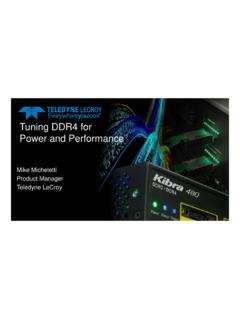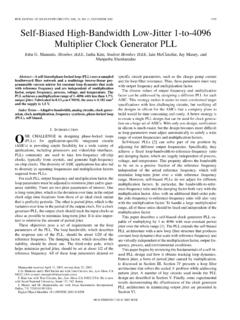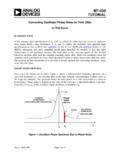Transcription of Jitter Measurements in Serial Data Signals - Teledyne LeCroy
1 Jitter Measurements in Serial data Signals Michael Schnecker, Product Manager LeCroy Corporation Introduction The increasing speed of Serial data transmission systems places greater importance on measuring Jitter with higher accuracy. Serial data standards normally require operation at an expected error rate of 10-12. While this represents only one bit error every hours at 100 Mb/s, it translates to one error every 4 minutes at 3Gb/s. It is, therefore, important to understand the characteristics of the Jitter in order to maintain system performance. Jitter is characterized by the relative variation in the location in time of the transitions of the signal level across a specific level (Figure 1). For clock Signals , the relative time between threshold crossings (rising-to-rising or falling-to-falling) is measured.
2 data Signals , on the other hand, generally require the measurement of the relative positioning of the data signal to that of the sampling clock, which is related to setup-and-hold time. Because of its random nature, Jitter is normally described in terms of its probability density function or PDF. Set up and hold time data Jitter PDF. Clock TIE TIE. Figure 1 Setup and hold time requirement for error-free operation. data transitions within the setup-and-hold time (gray area) will result in bit errors. Time interval error (TIE) is the time difference between clock and data edges, and the PDF of TIE is a measure of the probability of an edge occurring during the setup-and-hold time. The processes that make up Jitter are complex and come from many different random and non- random (deterministic) sources.
3 The PDF of the Jitter is the convolution of all individual component PDFs. Measurements are able to estimate the Jitter PDF, but are not able to determine the distributions of the random and deterministic parts of the overall distribution. The lack of exact Measurements for the Jitter distributions of Rj and Dj has lead to the use of a simplified model for the total Jitter . Equation 1 describes this model, which was first presented in the Fibrechannel MJSQ. document. Tj = (BER)*Rj + Dj (Eq. 1). Equation 1 is a heuristic that describes total Jitter as a function of bit error rate (BER) and is related to a distribution consisting of a Gaussian convolved with a pair of impulses, as shown in Figure 2. The constants Rj and Dj represent all of the components of random and deterministic Jitter .
4 The function (BER) is the total peak-to-peak Jitter of a unit normal distribution ( , a Gaussian with zero mean and a standard deviation of 1) at the specified bit error rate. The process of determining Rj and Dj involves finding the best fit values that solve equation 1. There are many possible ways to fit Rj and Dj to Equation 1, and since it is a simplification, no single set of solutions can completely describe the behavior of actual Jitter completely. It is for this reason that the SDA uses two separate methods to measure Rj and Dj effective and direct and presents these to the user. Figure 2 Jitter PDF model corresponding to the heuristic in Equation 1. The random Jitter is modeled by a Gaussian, and the deterministic Jitter by a pair of impulses separated by the value of the parameter Dj.
5 The curve shown is the convolution of Rj and Dj. Bit Error Rate and Jitter Equation 1 shows that the total Jitter is a function of bit error rate. This relationship is based on the effect that Jitter has on the bit error rate of a system. The bit error rate is influenced by other parameters of the system, such as noise, so it is not correct to say that BER and Jitter are equivalent. It is the contribution to the overall bit error rate caused by Jitter that is shown in Equation 1. A bit error will occur when the data signal transitions from one state to another during the setup-and-hold time as shown in Figure 1. Since Jitter has a random component, the location in time of the transitions varies over a range of values. The longer the transitions are observed, the greater this range will be.
6 Now, if we think of each transition in the data signal as the change in a bit value, then a transition at the wrong time ( , outside the setup-and-hold window) will lead to a bit error. The probability of this event is equivalent to the bit error rate contribution due to Jitter . The total Jitter gives a confidence interval for the Jitter in that it will not exceed a certain value to a confidence of (1-BER). In many specifications, the term bit error rate is commonly used in this context to refer to the Jitter confidence interval. Total Jitter The total Jitter is the peak-to-peak Jitter in a clock or data signal within a specified confidence equal to 1-BER. An example of a normally distributed Jitter PDF is shown in Figure 3. In order to determine the total Jitter from the PDF, the probability of the Jitter exceeding a certain value t must be evaluated.
7 This is done by integrating the PDF from a time t to + which will give the total probability of an edge occurring at or after this time. The probability can be computed for all values of t by integrating the PDF separately for t > 0 and t < 0. Figure 3 Probability of a data edge displacement greater than time t from the sampling clock. The mean value of the distribution is 0, which represents perfect alignment. Figure 4 Total Jitter curve. The vertical values of this curve represent the probability of a data transition occurring at a time represented by the horizontal axis. The horizontal center of the plot is 0 ps. The two markers are placed at the vertical level corresponding to a bit error rate of 10e-12, and the horizontal distance between these two points is the total Jitter at this bit error rate.
8 The resulting curve shown in Figure 4, gives the total probability of an edge being greater than t (or less than t). The contribution of Jitter to the system BER is given by the probability that an edge occurs at a time greater than t as we mentioned earlier. In order to guarantee a BER contribution from Jitter below a certain value, the positive and negative values of t are chosen so that the prob- ability of an edge at a time greater and less than these times is equal to the desired bit error rate. These Jitter values can be measured by finding the intersection between a horizontal line at the bit error rate and the total Jitter curve. The horizontal spacing between these two points is the total Jitter . A common way to view the total Jitter is by plotting the bit error rate as a function of sampling position within a bit interval.
9 This curve, commonly referred to as the bathtub curve is derived from the total Jitter curve by scaling it to one bit interval (UI). The right half of the bathtub curve is taken from the left half of the total Jitter curve, and the left half of the bathtub curve is taken from the right half of the total Jitter curve. The bathtub curve corresponding to the total Jitter curve in Figure 4. is shown in Figure 5. Extrapolating the PDF. Measuring the total Jitter requires that the probability density function of the Jitter is known exactly. The SDA measures the Jitter PDF by collecting a histogram of TIE Measurements . This histogram approximates the PDF by counting the number of edges occurring within the time period delimited by each bin in the histogram. In order to accurately measure Jitter contributions at very low bit error rates, such as 1012, the histogram must contain Measurements with populations that are below 1 in 1016 (one TIE measurement out of 1016 at a certain value).
10 This number of data transitions would take approximately 38 days at 3 Gb/s. Therefore, measuring this number of edges is clearly impractical. Figure 5 The bathtub curve is constructed by rescaling the total Jitter curve in Figure 4 to one unit interval, and centering the right side of the total Jitter curve at 0 UI. and the left side at 1UI (the left and right sides of the bathtub curve). A smaller data set is extrapolated in order to estimate the data for the larger sample size. Extrapolation of the measured histogram of TIE values uses the random nature of Jitter at the extremes of the histogram to extrapolate the bins below the 10th percentile and above the 90th percentile. The central part of the distribution is dominated by deterministic Jitter while the extremes are entirely random.















